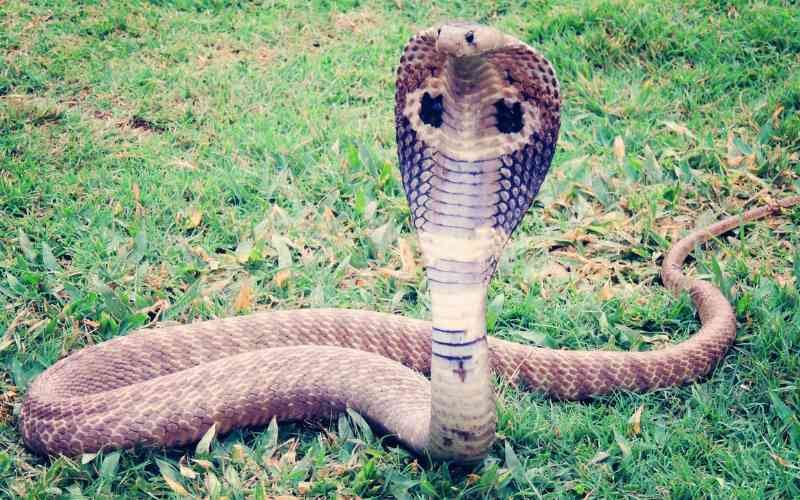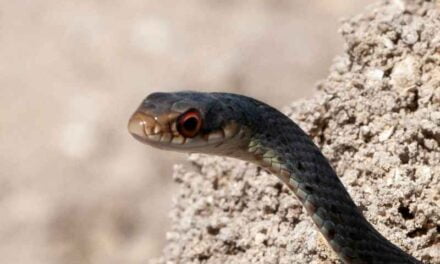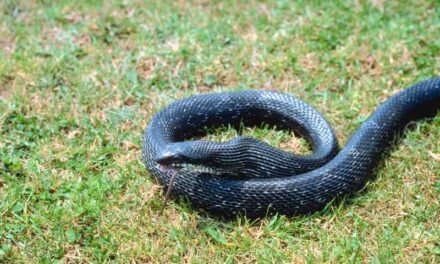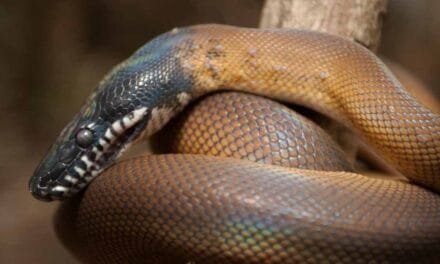The Egyptian cobra (Naja haje) is one of the most venomous snakes in North Africa, which has caused many snakebite incidents to humans. It averages roughly 1.4 meters (4.6 ft), with the longest recorded specimen measuring 2.59 metres (8.5 ft).² This snake is also known as Ouraeus (derived from the Ancient Greek word: οὐραῖος – Greek pronunciation: οὐραῖος), which means “the one who rises up”.² The Egyptian cobra has some amazing adaptations and behavior that help it survive and thrive in its environment.
Physical Adaptations
The most recognizable physical adaptation of the Egyptian cobra is its hood, which is formed by long cervical ribs that can expand when the snake feels threatened or agitated.²³ The hood makes the snake look bigger and more intimidating to potential predators or rivals. The hood also displays a “tear-drop” mark below the eye, which may serve as a warning signal or a distraction to the attacker.²
Another physical adaptation of the Egyptian cobra is its venom, which is delivered through two fixed fangs at the front of the mouth.² The venom of the Egyptian cobra is mainly neurotoxic, which means that it affects the nervous system and causes paralysis, respiratory failure, and death.² The venom also contains cytotoxic components, which cause tissue damage and necrosis.² The venom of the Egyptian cobra is powerful enough to kill a human within an hour if left untreated.²
The Egyptian cobra also has some other physical adaptations that help it cope with its environment. For example, it has a moderately broad and rounded snout, which allows it to dig into loose soil or sand to find shelter or prey.² It also has a cylindrical and stout body, which enables it to move swiftly and agilely on the ground.² It also has a long tail, which helps it balance and maneuver.²
Behavioral Adaptations
The Egyptian cobra is a highly adaptable snake that can live in a wide variety of habitats, such as steppes, dry to moist savannas, arid semi-desert regions with some water and vegetation, agricultural fields, scrub vegetation, and even near human settlements.²³ It can also swim in the water and has been reported to swim in the Mediterranean sea.²
The Egyptian cobra is mainly nocturnal, which means that it is most active at night.³⁴ This allows the snake to avoid the extreme heat of daytime in Egypt’s dry terrain. However, it can sometimes sunbathe in the wee hours of the morning to regulate its body temperature.³
The Egyptian cobra is terrestrial, which means that it lives on the ground.³ It often inhabits burrows made by other rodents or animals, where it can hide from predators or rest during the day.³ It can also climb trees or bushes to escape danger or find food.²
The Egyptian cobra is a carnivorous snake that feeds on a variety of prey, such as rodents, birds, lizards, frogs, fish, eggs, and even other snakes.²³ It hunts by using its keen sense of smell and sight to locate its prey. It then strikes quickly and injects its venom through its fangs. It then swallows its prey whole after killing it.
The Egyptian cobra is a solitary snake that only interacts with other cobras during mating season.³⁴ It can be very aggressive and territorial when confronted by another snake or a predator. It will try to escape first, but if provoked, it will stand upright, expand its hood, and strike with its venomous fangs.³ It can also spit its venom up to 3 meters (10 ft) as a defensive mechanism.²
The Egyptian cobra is an oviparous snake, which means that it lays eggs.³ It usually mates in the spring and lays 8 to 30 eggs in a hidden place, such as a hollow tree, a termite mound, or a rodent burrow.²³ The female cobra will guard the eggs until they hatch after 60 to 90 days.² The hatchlings are about 30 to 40 cm (12 to 16 in) long and are fully venomous from birth.²
The Egyptian cobra is a fascinating snake that has adapted well to its environment. It is revered and feared by many cultures and has a rich history and mythology. It is also one of the most dangerous snakes in the world and should be treated with respect and caution.
References
Works Cited:
(1) Egyptian cobra – Wikipedia. https://en.wikipedia.org/wiki/Egyptian_cobra
(2) Egyptian Cobra – Facts, Diet, Habitat & Pictures on Animalia.bio. https://animalia.bio/egyptian-cobra
(3) The Egyptian Cobra – Owlcation. https://owlcation.com/stem/The-Egyptian-Cobra
(4) Egyptian Cobra Facts, Description, Diet, Pictures – Animal Spot. https://www.animalspot.net/egyptian-cobra.html.
(5) How Are Cobras Adapted to Their Environments? | Pets on Mom.com. https://animals.mom.com/cobras-adapted-environments-5518.html.









